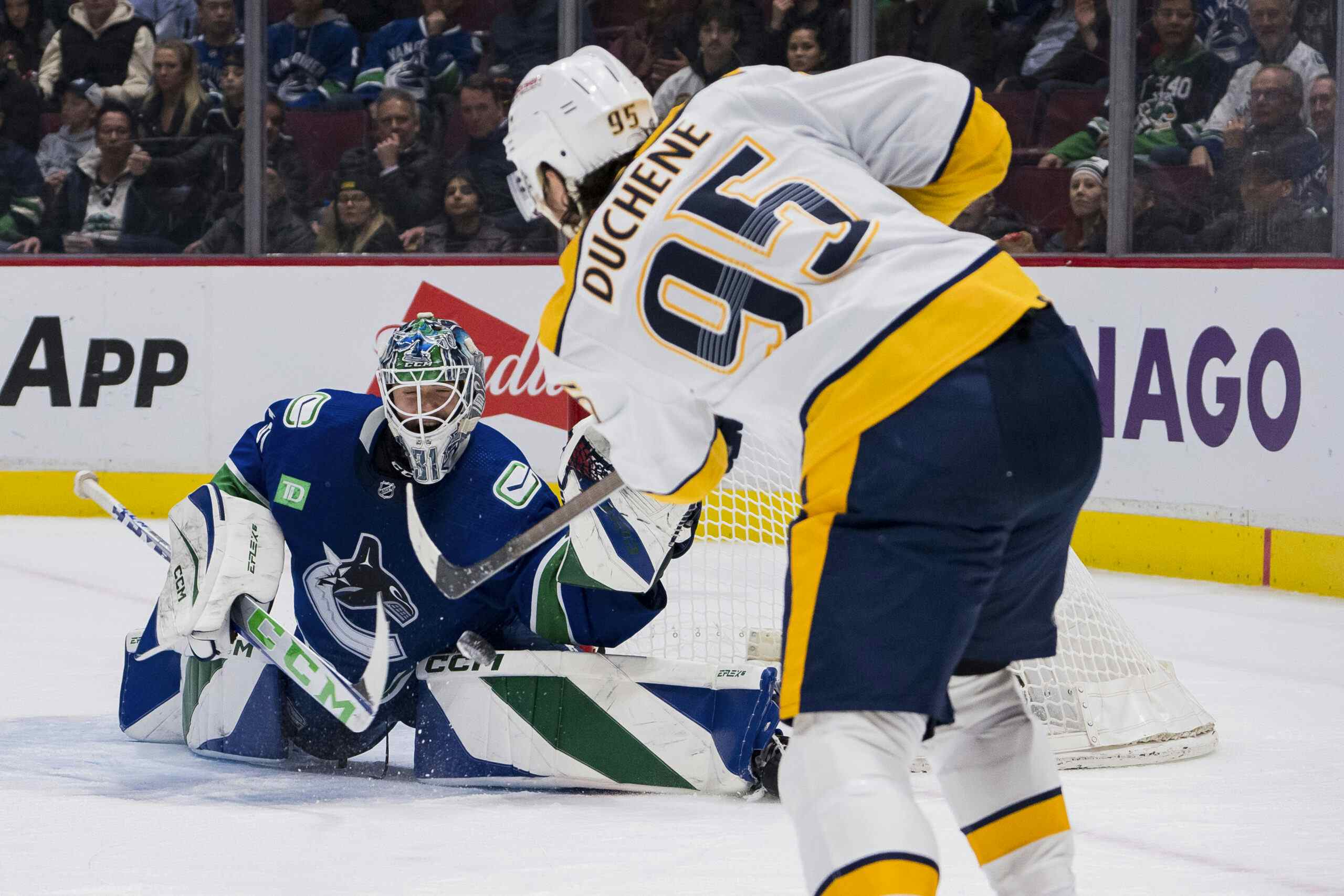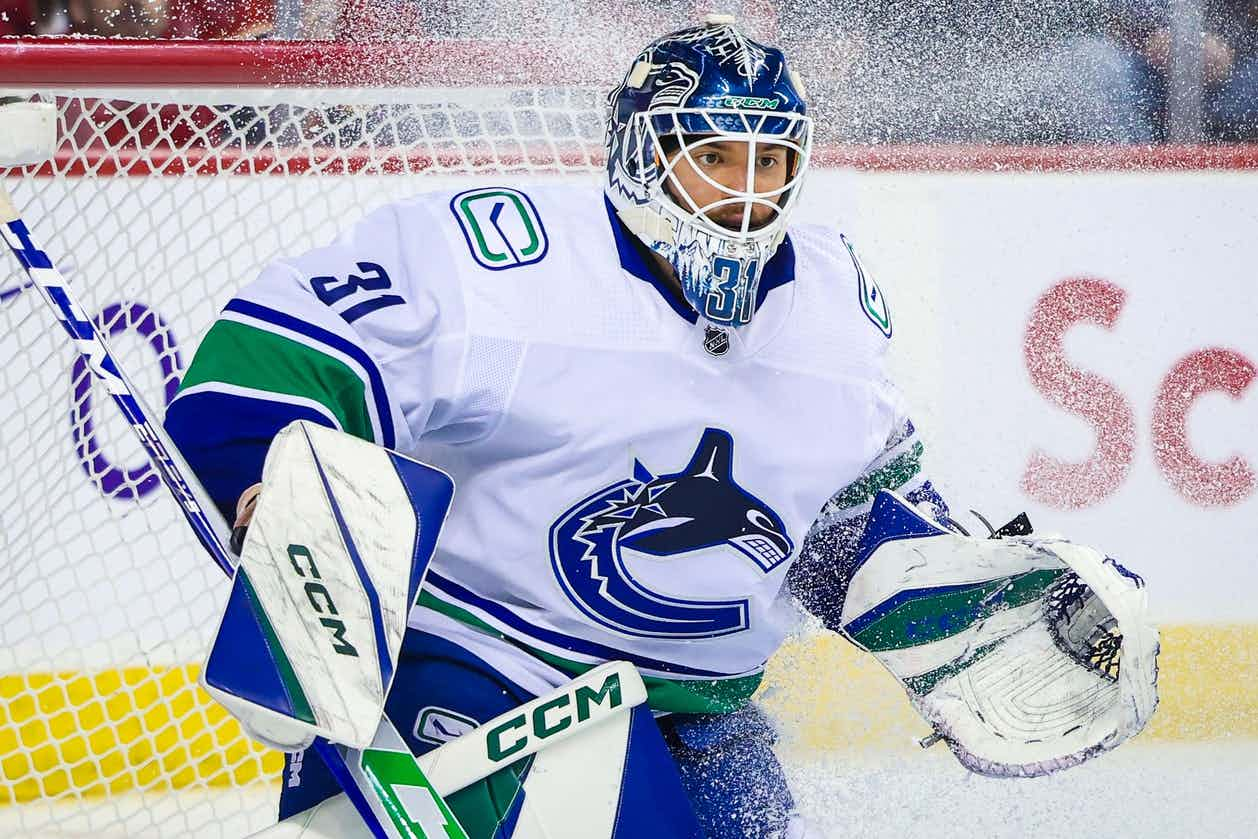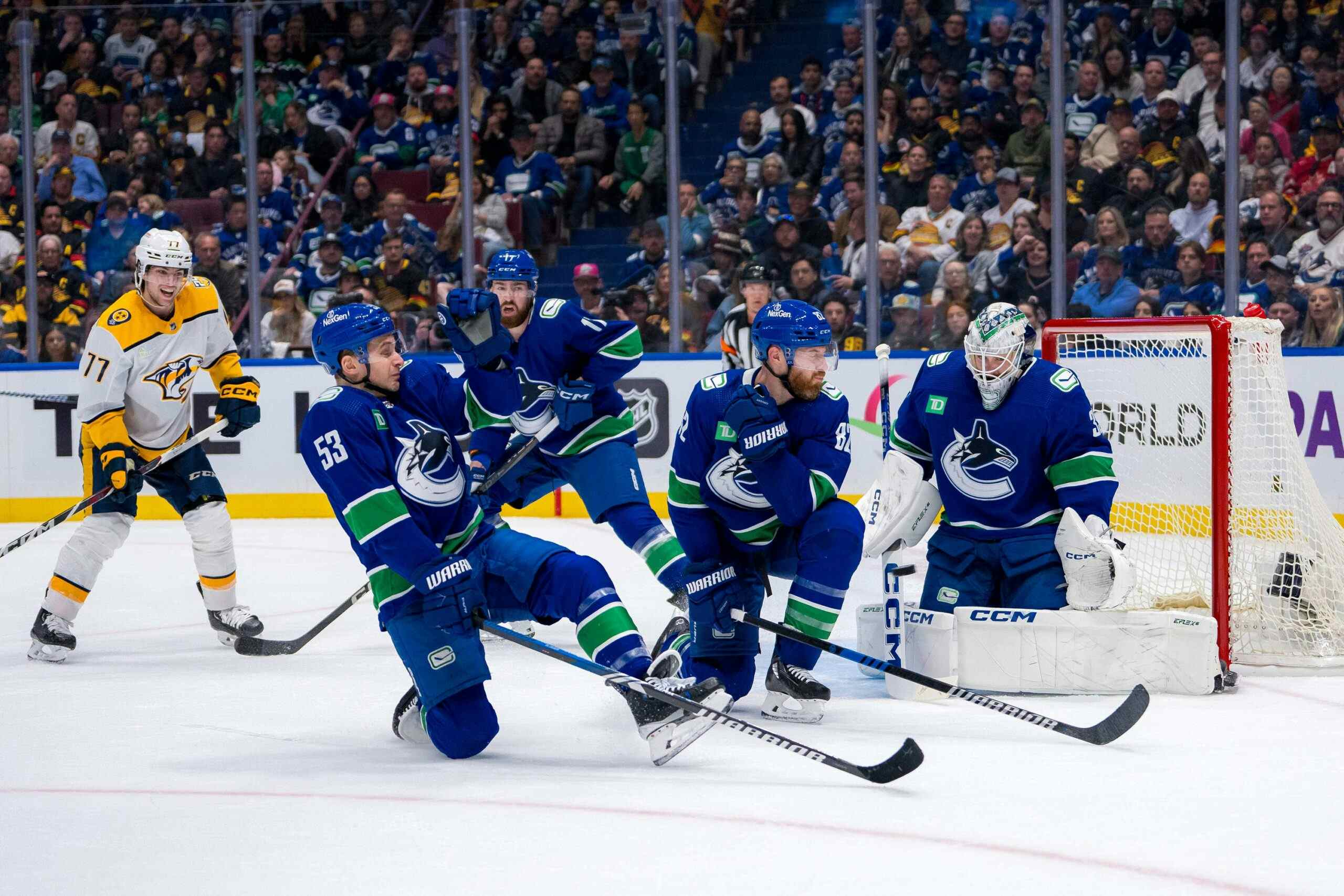With Kevin Bieksa, the Good Far Outweighs the Bad
By Jeff Angus
11 years ago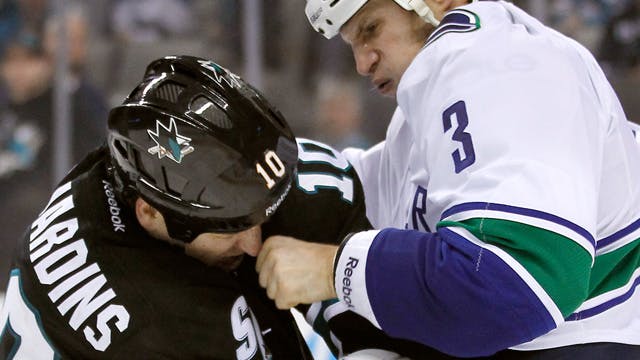
Kevin Bieksa has carried many labels during his tenure with the Canucks. At his best, he is a physical and instinctive two-way defenseman who can play on the power play and shut down opposing star forwards.
At his worst, he is an overly aggressive defenseman who goes out of position to make plays, both defensively and offensively.
He has battled through some pretty significant injuries in his career. He has formed one half of two of the best defensive pairings the Canucks have ever seen (with Willie Mitchell for a few seasons, and now with Dan Hamhuis).
Bieksa is also a difficult defenseman to analyze. Why? Read on to find out.
He, for the most part, has been a productive offensive defenseman (three 40+ point campaigns speak to that). His underlying numbers are pretty good over the years, too. But he doesn’t play the position like defenseman typically do. He was compared a lot to Chris Chelios when he was coming up through the AHL ranks in Manitoba, but that was more for his surly on-ice demeanor, love of fighting and mixing it up, and ability to generate offense at even strength and on the power play.
However, nearly a decade after making his NHL debut, the Chelios comparisons still ring true, but for more reasons than just the ones listed above. Chelios was also a difficult defenseman to analyze and compare against his peers. He obviously was a better defenseman than Bieksa; I am not trying to compare them in terms of overall skill or impact on the ice.
But Chelios and Bieksa zig when other defensemen zag. They played the position that was typically manned by players two or three inches taller and 15 to 20 pounds heavier.
Where the two defensemen are most similar is with two things – having active sticks and playing instinctive hockey. Bieksa relies a lot on his active stick to make defensive plays, and he is very good at it. Having a good stick is essential for any NHL defenseman, especially one who is giving up size and strength to most opposing forwards. I realize that sounds like something Pierre McGuire would discuss, but it does have a lot of merit. Additionally, Chelios was able to be such a dominant defenseman for so long because of his instincts. He didn’t play sound positional hockey all of the time. He didn’t always/ever make the safe play. He would rush up the ice when other defensemen may hang back. He would attack a puck carrier when other defensemen would sit back and give a bit of a gap.
Bieksa plays largely the same way. When it is working for him, he makes tough minutes look pretty easy. He is a good skater and he knows his limitations. But this playing style also leads to some bouts of inconsistent play. When Bieksa makes a poor read or an overly-aggressive play on a puck carrier, he is often going to get caught further out of position than most other defensemen who rely on keeping a strict gap and making the percentage play off of the boards.
I wanted to take a few plays to highlight both Bieksa the good and Bieksa the bad. A few from this season, and one is from the postseason a few years back (I couldn’t find more recent footage of a similar play… and that must be a good sign).
Bieksa the Good:
Bieksa and Hamhuis have been one of the best and most consistent pairings in the NHL since they were put together a few years ago. The naked eye test (watching games) and the underlying numbers (such as Rob Vollman’s 2011-12 Player Usage Charts) both confirm this.
Bieksa’s breakaway backhand goal against Dallas was not a goal that many defensemen would score. Not because of the deke or shot Bieksa used to beat the goaltender (a one-handed backhand is a bold move), but because of how the play came about.
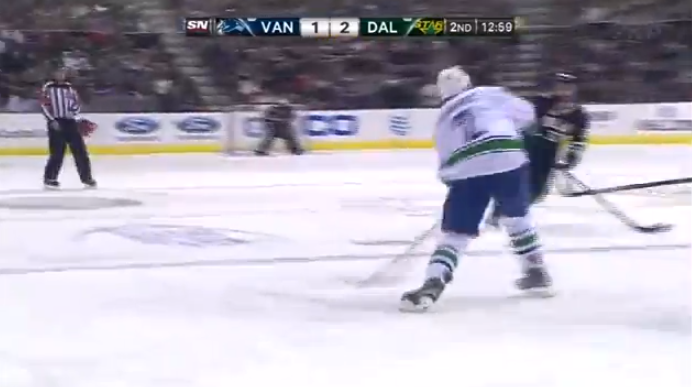
Hamhuis looks up the ice for a target to pass the puck to.
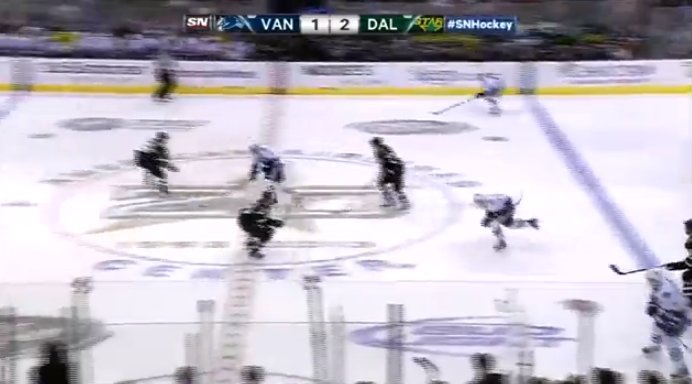
And he finds Bieksa, his defensive partner.
Bieksa, a defenseman (at least he is listed as one), is well ahead of the Vancouver forwards on the rush. And he is taking the puck up against three Dallas players. Most defensemen would dump the puck in when a scenario like this arises.
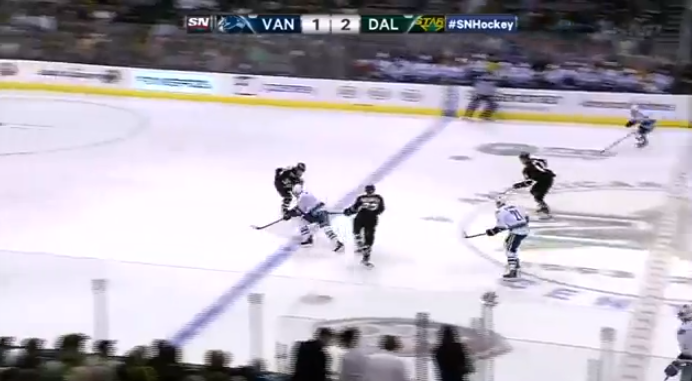
Bieksa changes gears and blows by Philip Larsen, who is caught standing still (a move that we sometimes see from Bieksa when he is struggling). Larsen’s gap is non-existent.

He does a great job shielding the puck from a sliding/diving Larsen (again, a move we sometimes see from a struggling Bieksa).
This ability to generate offense against the grain and at even strength is something that Vancouver has really missed since letting Christian Ehrhoff walk back in the summer of 2011.
Bieksa also scored a very similar goal in the postseason against the Blackhawks in 2011.
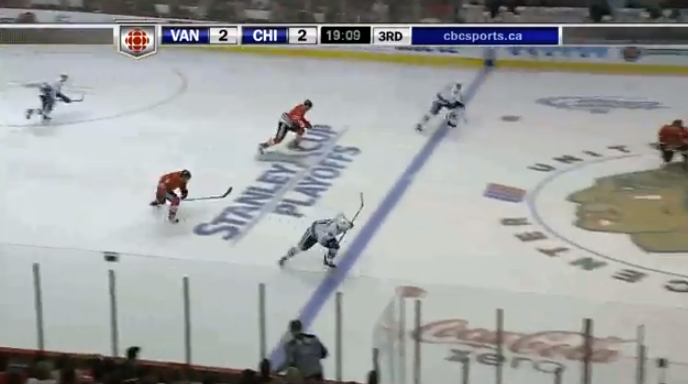
Bieksa joins Mason Raymond for a two-on-two rush in the third period of a very important playoff game. Again, many defensemen would sit back and let Raymond carry it in or dump it in. Bieksa senses an opportunity to create something offensively.
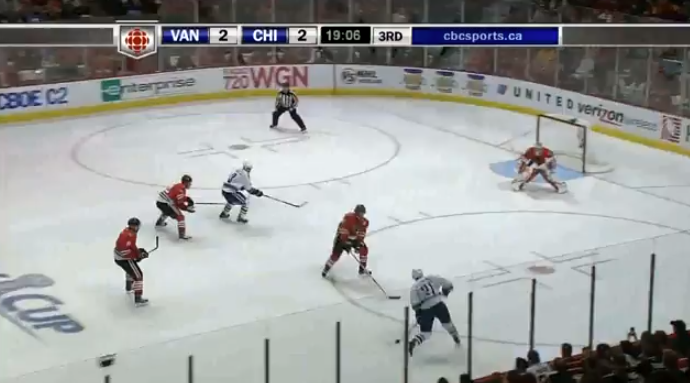
He manages to get in behind the Chicago defense. And instead of peeling off and trying to get back in position in case the puck misses the net, he does what a good forward would do and he heads straight for the net.
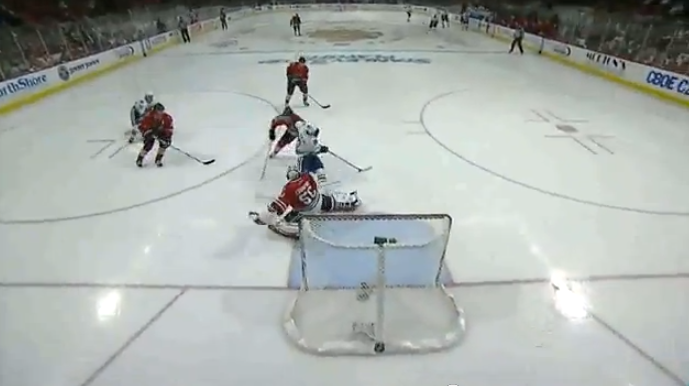
He makes a great move in close to pot the Mason Raymond rebound.
And earlier in the same shift, Bieksa displayed his instinctive defense and active stick.

He overplays on Jonathan Toews, trying to force him into the corner. Toews doesn’t bite and makes a quick turn to bring the puck to his forehand. Most defensemen would have angled Toews into the corner and tried to apply pressure up against the boards.
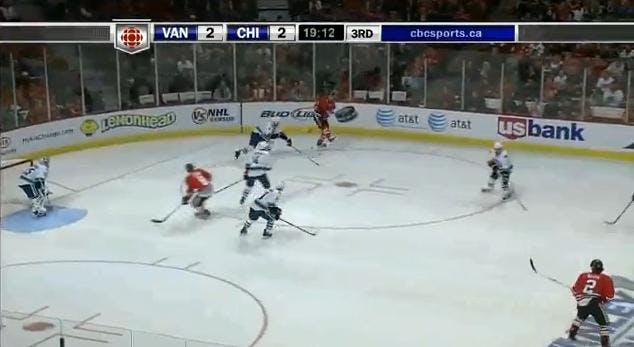
Bieksa quickly gets his stick in the way to disrupt the pass – he played the one-on-one sequence beautifully. And not long after this he jumps the zone to join Raymond on the rush.
Bieksa the Bad:
Here are two examples of when Bieksa’s playing style can get him in trouble.
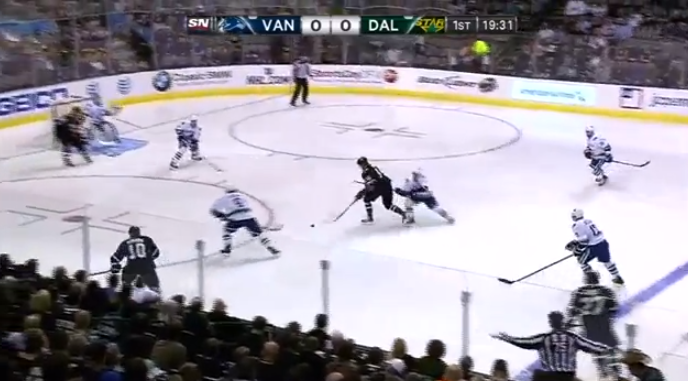
The first came during Jamie Benn’s first period tally from last week. Bieksa, instead of playing Benn positionally, charges at him and attempts to knock him off the puck before he gets to the slot. Benn is a big kid and one of the stronger players on the puck in the entire league, and he gets around Bieksa quite easily. And he also leaves Hamhuis to defend the goal, Jagr, and Benn all by himself.
And the second came during another playoff series with Chicago – from 2010 this time. Apologies in advance for reopening some past wounds.
Kris Versteeg scored the goal, and Bieksa is caught swimming as he attempts to break up the pass. He has gotten better at picking his spots when diving to block passes, but it is still a very high-risk, high-reward play as it renders him completely ineffective if he doesn’t time it perfectly.

It is easy to dissect hockey plays with the benefit of frame-by-frame analysis, but Bieksa probably would have been better off clearing out and letting Roberto Luongo see the Keith shot. Either way, he wants to challenge the play. This is a great example of what "collapse defense" looks like as a playing style.
.png&w=3840&q=75)
Keith easily passes it around him (you will also notice Keith with his left elbow up – must be a habit).
.png&w=3840&q=75)
And Versteeg has a wide open net and no Canuck in front of him.
Bieksa isn’t the perfect defenseman, but he has been a very good one with the Canucks for a long time. Because of his unique playing style, it is tough to compare him to his peers (both on the team and throughout the league). And, for the most part, Vancouver fans have learned to accept the bad with the good. Bieksa is at his best when he is making confident reads. Sometimes this leads to mistakes and odd-man rushes against, but more of then than not it leads to a positive outcome (outlet pass or scoring chance) for the Canucks.
It has taken Bieksa a while to find himself in the NHL. He was an instant hit in the AHL as a rookie, both on the ice (39 points and 192 PIM in 2004-05) and off of it (just ask Fedor Fedorov). He was pretty solid as a rookie in the NHL too, although his debut season was cut short by the infamous Eric Weinrich acquisition.
Bieksa has three seasons of 40+ points. He has played over 80 games in a season only once. He has scored one of the biggest goals in franchise history. He has been viewed by fans as both untouchable and a player that needs to be traded away. He gives fantastic interviews, he is a funny guy, and he does a pretty spot on Ryan Kesler impression. He’s not without his faults, though. But if there is one thing Canuck fans have learned to love over the years, it is imperfection. Embrace the imperfection doesn’t have the same ring to it, but it does sum up Vancouver hockey over the years.
Other Posts from Jeff (@anguscertified):
Recent articles from Jeff Angus

